The Rise of NFT dApps: What You Need to Know About Creating an NFT dApp?
Ethereum API refers to programming interfaces allowing developers to interact with the Ethereum blockchain programmatically. As a decentralized blockchain platform, Ethereum enables developers to build decentralized applications (dApps) and smart contracts. However, developers often utilize APIs to interact with the Ethereum network and access its data.
One of the latest developments in the Ethereum ecosystem is the ongoing transition to Ethereum 2.0, also known as Eth2 or Serenity. Ethereum 2.0 aims to address scalability, security, and sustainability issues the current Ethereum network faces. The transition involves implementing a proof-of-stake (PoS) consensus mechanism, replacing the existing proof-of-work (PoW) mechanism, and increasing transaction throughput and energy efficiency.
Additionally, Ethereum 2.0 introduces shard chains to enable parallel transaction processing, further enhancing the network’s scalability. This upgrade represents a significant milestone for Ethereum, paving the way for broader adoption and increased usability of decentralized applications (dApps) on the platform.
In essence, smart contracts empower developers to create trustless and transparent systems where transactions and agreements are executed automatically according to predefined rules, significantly reducing the need for human intervention and streamlining processes in various industries.
The Ethereum ecosystem is witnessing growth in various sectors beyond finance and NFTs, including decentralized identity, supply chain management, governance, and decentralized autonomous organizations (DAOs).
Use cases of Ethereum on-chain dataEthereum on-chain data provides a wealth of information that can be leveraged for various purposes. Here are some use cases of Ethereum on-chain data:
- Transaction Analysis: On-chain data enables analysts to examine transaction patterns, including metrics such as transaction throughput, transaction volume, and transaction size. This analysis offers valuable insights into user behavior, network activity, and trends in Ethereum usage.
- Smart Contract Monitoring: Ethereum on-chain data enables monitoring and analysis of smart contracts deployed on the blockchain. This includes tracking contract interactions, monitoring contract state changes, and identifying potential vulnerabilities or security issues.
- Token Analytics: On-chain data provides information about Ethereum-based tokens, including token transfers, balances, and holdings. This data can be used to analyze token distributions, track token movements, and monitor token-related activities such as token sales or airdrops.
- Decentralized Finance (DeFi) Analysis: Ethereum’s on-chain data is precious for analyzing decentralized finance (DeFi) protocols and applications. This includes studying lending and borrowing activity, liquidity provision, yield farming strategies, and protocol governance.
- Market Intelligence: Ethereum on-chain data can provide valuable insights for traders and investors in the cryptocurrency market. This includes tracking large transactions (“whale” activity), monitoring exchange inflows and outflows, and analyzing on-chain indicators such as transaction volume and velocity.
- NFT (Non-Fungible Token) Analysis: With the rise of NFTs, Ethereum on-chain data is increasingly used to analyze NFT markets, track NFT ownership and trading activity, and monitor trends in the NFT space.
- Blockchain Forensics and Compliance: On-chain data can be used for blockchain forensics and compliance purposes, including identifying illicit activities such as money laundering or fraud, tracing the source and destination of funds, and ensuring compliance with regulatory requirements.
- Research and Development: Ethereum on-chain data provides valuable insights for researchers and developers working on blockchain technology. This includes studying network scalability, protocol upgrades, consensus mechanisms, and emerging trends in blockchain development.
Bitquery is a blockchain data analytics platform that provides comprehensive tools and insights for analyzing blockchain data across multiple blockchain networks. It offers a suite of APIs, data visualization tools, and data sets that enable developers, researchers, and businesses to explore, query, and extract valuable insights from blockchain data. Bitquery’s platform aggregates and indexes blockchain data in real-time, allowing users to track transactions, addresses, smart contracts, tokens, and other on-chain activities. Here is a brief of the data provided by Bitquery:
 Fig. Bitquery
Fig. Bitquery- Transactions: Bitquery provides detailed information about individual transactions on the blockchain. This includes transaction hash, sender and recipient addresses, transaction value, and timestamp of the transaction.
- Transfers: Bitquery provides information about token transfers, including the token type, sender and recipient addresses, token amount transferred, transaction hash, and timestamp.
- Trades: Bitquery offers insights into cryptocurrency trades that occur on decentralized exchanges (DEXs) and centralized exchanges. This includes information about the traded assets, trade prices, trade volumes, trading pairs, transaction hash, and timestamps of trades.
- Blocks: Blocks are the building blocks of blockchain networks, containing a collection of transactions. Bitquery provides information about individual blocks, including block hash, block height, number of transactions included in the block, timestamp, and other block-related data.
- NFTs (Non-Fungible Tokens): Bitquery offers information about Non-Fungible Tokens, which are unique digital assets that represent ownership of a particular item or asset. This includes details about NFT transactions, token metadata, ownership history, and related information.
These terms can be best understood by analyzing an Ethereum mainnet based address. What we require is to run a smart contract query which gives information about, Similarly query can be executed for transactions, methods etc. You can start using the APIs today with the free developer plan.
2. Etherscan APIEtherscan API allows developers and users to programmatically access a wide range of data and information stored on the Ethereum blockchain. With the Etherscan API, users can retrieve details about transactions, blocks, smart contracts, tokens, addresses, and more. It provides functionalities such as querying transaction details, checking account balances, obtaining token information, tracking smart contract interactions, and monitoring network activity. Here is a brief of the data provided by Etherscan API::
 Fig. Etherscan API
Fig. Etherscan API- Transactions: The Etherscan API allows users to retrieve detailed information about individual transactions on the Ethereum blockchain. This includes data such as transaction hash, sender and recipient addresses etc.
- Transfers: Similar to transactions, the API provides information about token transfers on the Ethereum blockchain. This includes the token type, sender and recipient addresses, etc.
- Trades: Etherscan API does not specifically provide data about trades as it primarily focuses on on-chain transactions and data
- Blocks: Users can query information about individual blocks on the Ethereum blockchain using the Etherscan API.
- NFTs: Etherscan API offers some capabilities for querying information related to NFTs. Users can retrieve data about NFT token contracts, including token metadata, ownership, transfers, and transaction history associated with specific NFT tokens.
- Token Information: The API provides extensive information about Ethereum-based tokens. This includes details such as token name, symbol, etc.
Infura API primarily serves as an Ethereum and IPFS infrastructure provider, offering access to Ethereum nodes and related services. While it provides infrastructure for interacting with the Ethereum network. Developers use Infura API to interact with Ethereum nodes, send transactions, deploy smart contracts, and access blockchain data programmatically. With Infura API, developers can perform various operations, including:
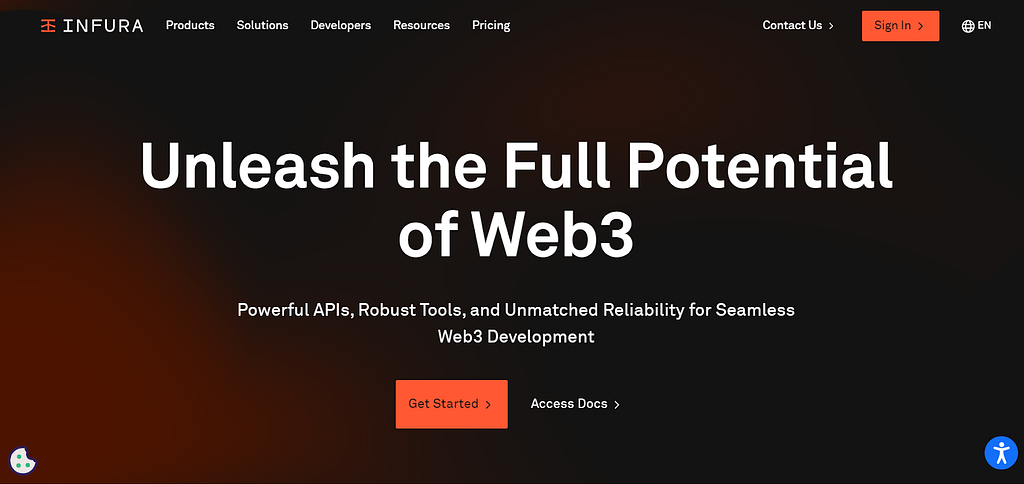 Fig. Infura API
Fig. Infura API- Querying Blockchain Data: Developers can retrieve information about transactions, blocks, account balances, smart contracts, and other blockchain-related data from Ethereum nodes.
- Sending Transactions: Infura allows developers to send transactions to the Ethereum network. This includes sending Ether (ETH) between accounts, interacting with smart contracts, and deploying new contracts.
- Accessing Ethereum Network: Infura API provides access to Ethereum nodes, allowing developers to connect to the Ethereum network without running their own node. This enables developers to build decentralized applications (dApps) and interact with the Ethereum blockchain without the overhead of managing a node.
- Monitoring Blockchain Events: Developers can subscribe to blockchain events such as new block creations, transaction confirmations, and smart contract events using Infura API. This allows applications to react to changes on the Ethereum blockchain in real-time.
- IPFS Integration: In addition to Ethereum services, Infura also offers IPFS (InterPlanetary File System) integration. Developers can use Infura to interact with the IPFS network, including storing and retrieving files.
Alchemy API provides infrastructure services for interacting with blockchain networks, primarily Ethereum. It offers robust tools for developers to build and scale decentralized applications (dApps) and interact with the Ethereum blockchain. Alchemy API enables developers to perform various operations such as:
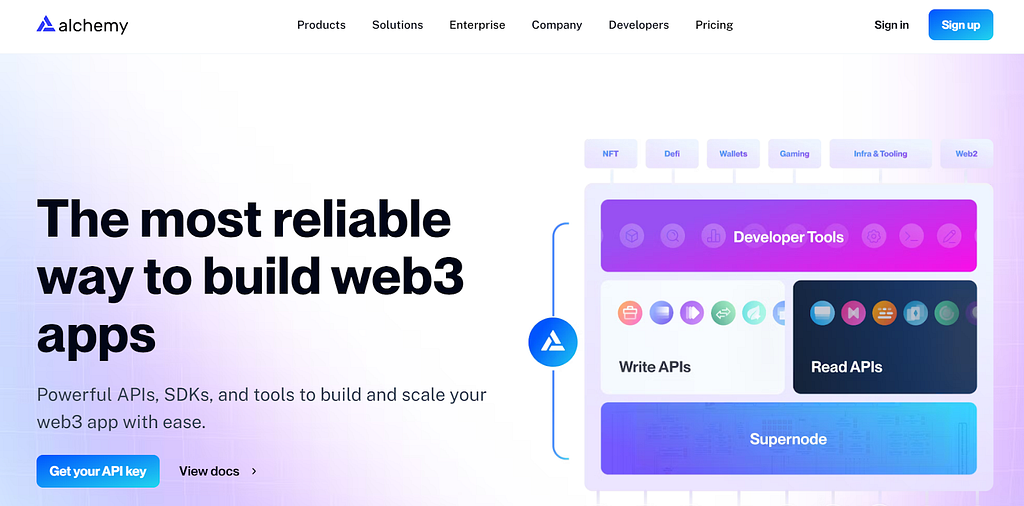 Fig. Alchemy API
Fig. Alchemy API- Node Services: Alchemy provides access to Ethereum nodes, allowing developers to connect to the Ethereum network without running their own node. Developers can use Alchemy’s node services to query blockchain data, send transactions, and interact with smart contracts.
- Data Infrastructure: Alchemy offers scalable and reliable data infrastructure for storing and retrieving blockchain data. This includes historical blockchain data, real-time updates, and indexed data for efficient querying.
- Developer Tools: Alchemy provides developer tools and APIs that simplify building and scaling dApps on Ethereum. This includes tools for monitoring application performance, debugging smart contracts, and managing Ethereum accounts.
- Blockchain Analytics: Developers can use Alchemy’s infrastructure to build custom analytics solutions. This may involve querying blockchain data, analyzing transaction patterns, and extracting insights from the Ethereum blockchain.
- Integration with Web3 Libraries: Alchemy seamlessly integrates with Web3 libraries such as Web3.js and Web3.py, allowing developers to interact with Ethereum nodes and smart contracts from their applications.
Ethplorer API is a tool for accessing data and information related to Ethereum-based tokens. It offers a comprehensive set of APIs that allow developers, researchers, and users to retrieve data about token transactions, transfers, token details, and more on the Ethereum blockchain. Ethplorer API provides details such as token name, symbol, and even NFT-related activities. Here is a brief of the data provided by Ethplorer API:
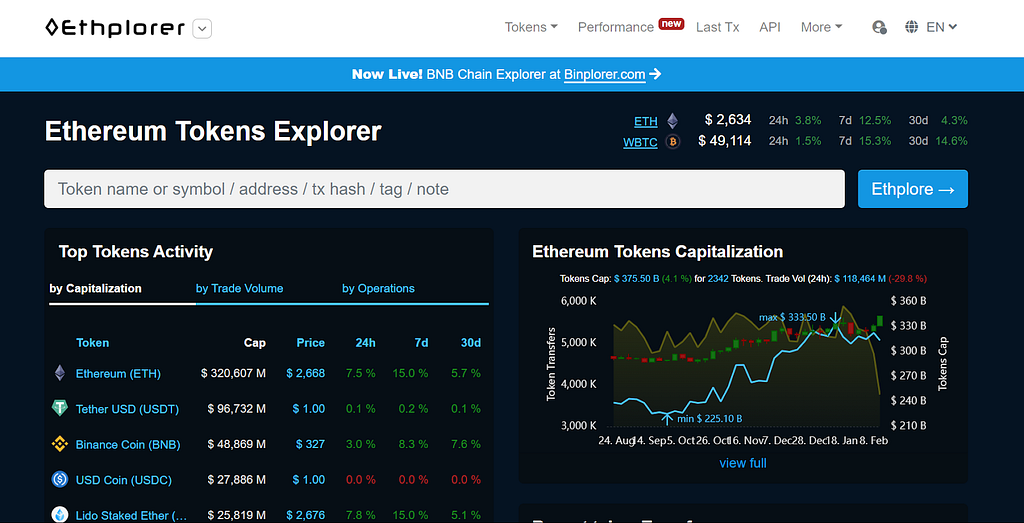 Fig. Ethplorer API
Fig. Ethplorer API- Transactions: Ethplorer API allows users to retrieve information about token transactions on the Ethereum blockchain. This includes details such as transaction hash, sender and recipient addresses, token amount transferred, transaction status, and timestamps.
- Transfers: Ethplorer API provides data on token transfers, which involves the movement of tokens between Ethereum addresses. Users can access information about the sender and recipient addresses, token amount transferred, transaction hash, timestamps, and any associated metadata.
- Trades: Ethplorer API may not directly provide information about trades. However, it can offer insights into token transfers that may be associated with trades on decentralized exchanges (DEXs) or centralized exchanges.
- Blocks: Ethplorer API focuses on token-related data rather than block-level information. Users typically use other blockchain explorers or APIs to retrieve data about Ethereum blocks.
- NFTs: Ethplorer API can provide data on transactions and transfers involving non-fungible tokens (NFTs) on the Ethereum blockchain. This includes details about NFT token contracts, token metadata, ownership history, and transfer transactions.
- Token Information: Ethplorer API offers extensive information about Ethereum-based tokens. This includes token details such as token name, symbol, total supply, decimal places, contract address, token holders, token transfers, and historical data such as price and trading volume if available.
CryptoCompare API primarily provides data and information related to cryptocurrency markets, including pricing, trading volume, and historical data for various cryptocurrencies. CryptoCompare API offers information about cryptocurrency prices, market data, and trading activity. Here’s a breakdown of the information typically conveyed by CryptoCompare API:
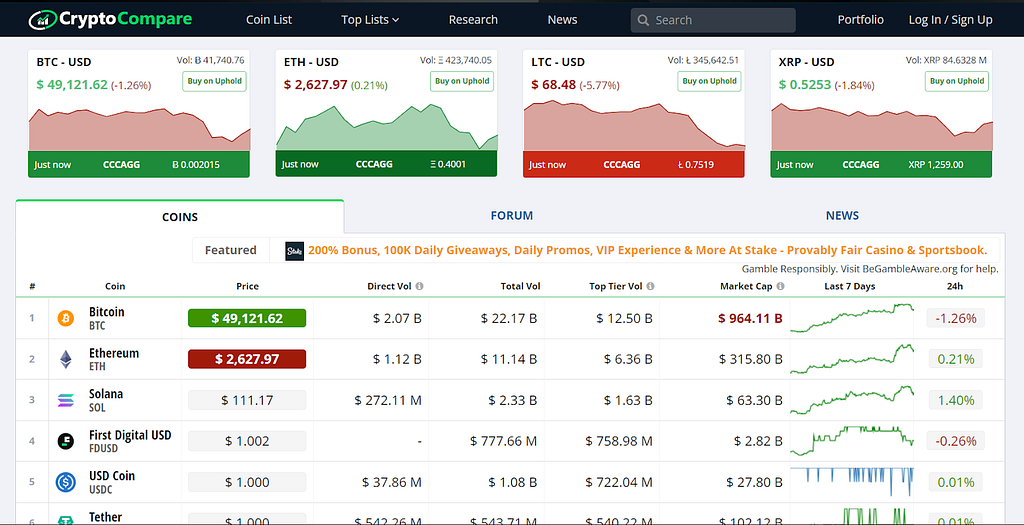 Fig. CryptoCompare
Fig. CryptoCompare- Cryptocurrency Prices: CryptoCompare API offers real-time and historical pricing data for cryptocurrencies, including current market prices, trading volume, market capitalization, price changes over time, and other market metrics.
- Trading Data: The API provides information about cryptocurrency trading activity, including trade prices, trading volume, trading pairs, exchange rates, order book data, and trade history on various cryptocurrency exchanges.
- Market Analysis: CryptoCompare API offers tools and data for conducting market analysis, including price charts, technical indicators, market trends, and sentiment analysis for cryptocurrencies.
- Historical Data: Users can access historical data for cryptocurrencies, including historical price data, trading volume, market capitalization, and other market metrics over different time periods.
- Top Lists and Rankings: The API provides lists and rankings of cryptocurrencies based on various criteria, such as market capitalization, trading volume, price performance, and other factors.
Nomics API primarily focuses on providing cryptocurrency market data and analytics, including information about token prices, trading volume, market capitalization, and other market metrics. Nomics API offers data related to cryptocurrency markets. Here’s a breakdown of the information typically conveyed by Nomics API:
- Cryptocurrency Prices: Nomics API offers real-time and historical pricing data for cryptocurrencies, including current market prices, trading volume, market capitalization, price changes over time, and other market metrics.
- Market Data: The API provides comprehensive market data for cryptocurrencies, including trading volume, market capitalization, circulating supply, total supply, and other market-related metrics.
- Market Analysis: Nomics API offers tools and data for conducting market analysis, including price charts, technical indicators, market trends, and sentiment analysis for cryptocurrencies.
- Historical Data: Users can access historical data for cryptocurrencies, including historical price data, trading volume, market capitalization, and other market metrics over different time periods.
- Rankings and Indices: The API provides rankings and indices of cryptocurrencies based on various criteria, such as market capitalization, trading volume, price performance, and other factors.
Web3.js is a JavaScript library that allows developers to interact with the Ethereum blockchain and smart contracts from web applications. While Web3.js is a tool for building decentralized applications (dApps) and interacting with the Ethereum network. Web3.js enables developers to perform various operations and retrieve information from the Ethereum blockchain, including:
 Fig. Web3.js
Fig. Web3.js- Transactions: Web3.js allows developers to send transactions to the Ethereum network and retrieve information about transaction status, transaction hashes, sender and recipient addresses, transaction values, gas fees, and timestamps.
- Transfers: Developers can use Web3.js to interact with ERC-20 and ERC-721 tokens on the Ethereum blockchain, allowing them to transfer tokens between addresses, retrieve token balances, and monitor token-related events.
- Blocks: Web3.js provides methods for querying information about Ethereum blocks, including block hashes, block numbers, block timestamps, and the number of transactions included in each block.
- NFTs: While Web3.js does not specifically provide functionality for NFTs, developers can use the library to interact with ERC-721 tokens, which are commonly used for representing NFTs on the Ethereum blockchain. This includes transferring NFTs between addresses, querying NFT metadata, and monitoring NFT-related events.
- Token Information: Web3.js allows developers to retrieve information about ERC-20 and ERC-721 tokens deployed on the Ethereum blockchain, including token names, symbols, decimals, total supplies, and token balances for specific addresses.
The Graph is a decentralized protocol and API for indexing and querying data from blockchain networks, including Ethereum. It primarily focuses on indexing and querying data from smart contracts and decentralized applications (dApps). However, developers can use The Graph to index and query data from specific smart contracts and dApps on the Ethereum blockchain Here’s how The Graph can be leveraged to retrieve such information:
 Fig. The Graph
Fig. The Graph- Transactions and Transfers: Developers can create subgraphs (indexing schemas) to index transactions and transfer data from specific smart contracts on the Ethereum blockchain. This allows them to query transactions and transfer information, including sender and recipient addresses, transaction values, gas fees, timestamps, and transaction status.
- Blocks: While The Graph does not directly index block-level data, developers can index data related to specific blocks from smart contracts or dApps. This may include information about block numbers, block hashes, timestamps, and other block-related data stored within smart contracts.
- NFTs: Developers can create subgraphs to index data related to non-fungible tokens (NFTs) from specific smart contracts on the Ethereum blockchain. This allows them to query information about NFT token contracts, token metadata, ownership history, transfer transactions, and other NFT-related activities.
- Token Information: Developers can create subgraphs to index data related to Ethereum-based tokens from specific smart contracts. This allows them to query information about token contracts, token metadata, token balances, token transfers, and other token-related data.
Blocknative API specializes in providing real-time mempool data and transaction monitoring services for Ethereum and other blockchain networks. Here’s an overview of the information conveyed by Blocknative API regarding transactions, transfers, trades, blocks, NFTs, and token information:
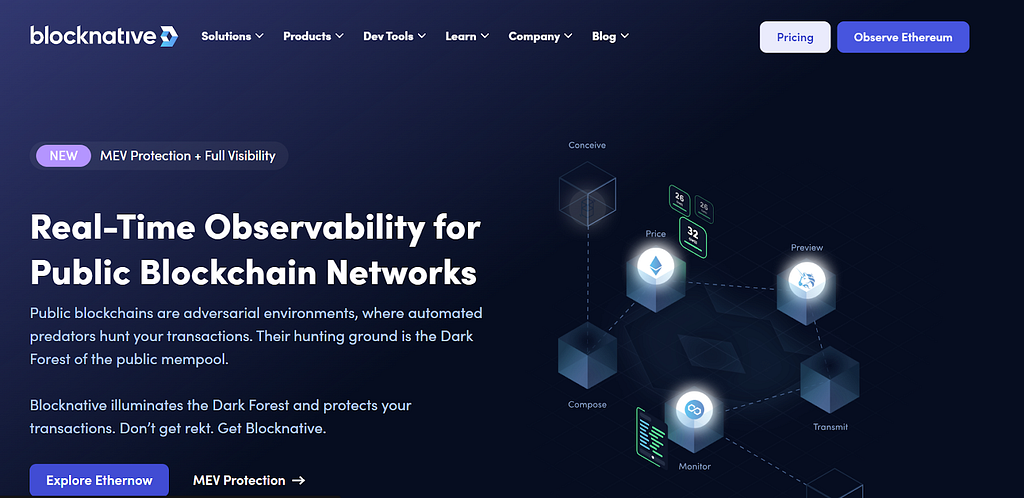 Fig. Blocknative API
Fig. Blocknative API- Transactions: Blocknative API offers real-time monitoring and insights into pending transactions in the Ethereum mempool. This includes data such as transaction hashes, sender and recipient addresses, transaction values, gas fees, nonce, and status (pending, confirmed, failed).
- Transfers: While Blocknative API does not directly provide information about token transfers, it offers real-time monitoring of pending transactions, which may include token transfer transactions. Developers can use this data to track pending token transfers and monitor transaction status.
- Trades: Blocknative API focuses on providing mempool data rather than trade-specific information. However, developers can use the API to monitor pending transactions that may be associated with trades on decentralized exchanges (DEXs) or centralized exchanges.
- Blocks: Blocknative API provides insights into pending transactions and mempool activity, rather than block-level data. Users can monitor pending transactions and track block confirmations in real-time.
- NFTs: While Blocknative API does not specifically provide information about NFTs, developers can use the API to monitor pending transactions related to NFTs. This includes tracking pending transactions for NFT token transfers and monitoring NFT-related events in the mempool.
- Token Information: Blocknative API does not directly provide information about token details or token-related data. However, developers can use the API to monitor pending transactions involving tokens and track token transfer activity in real-time.
ZettaBlock is a blockchain data platform that provides comprehensive information and analytics for various blockchain networks, including Ethereum. It offers information regarding transactions, transfers, trades, blocks, NFTs, and token information on the Ethereum blockchain. Here’s a breakdown of the information conveyed:
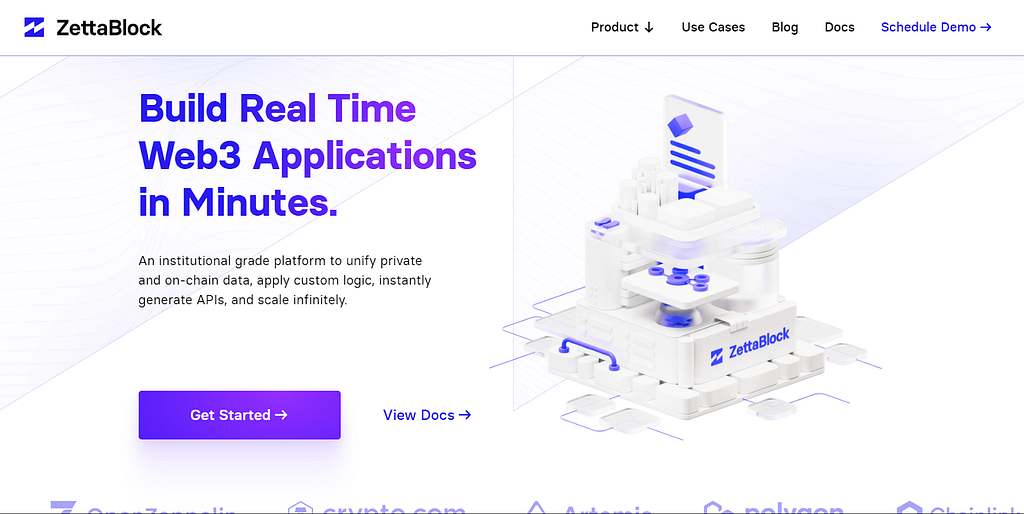 Fig: ZettaBlock
Fig: ZettaBlock- Transactions: ZettaBlock would provide details about individual transactions on the Ethereum blockchain, including transaction hashes, sender and recipient addresses, transaction values, gas fees, timestamps, and transaction status.
- Transfers: Similar to transactions, ZettaBlock would offer information about token transfers on the Ethereum blockchain, including details such as the token type, sender and recipient addresses, token amount transferred, transaction hashes, timestamps, and metadata if available.
- Trades: ZettaBlock may provide insights into cryptocurrency trading activity on various exchanges. This could include information about token transfers associated with trades on decentralized exchanges (DEXs) or centralized exchanges.
- Blocks: ZettaBlock would offer data related to individual blocks on the Ethereum blockchain, including block numbers, block hashes, timestamps, and the number of transactions included in each block.
- NFTs: ZettaBlock may offer information and analytics related to non-fungible tokens (NFTs) on the Ethereum blockchain. This could include details about NFT token contracts, token metadata, ownership history, transfer transactions, and NFT-related activities.
- Token Information: ZettaBlock would provide extensive information about Ethereum-based tokens, including token names, symbols, total supplies, decimal places, contract addresses, token holders, token transfers, and historical data such as price and trading volume if available.
Pentacle is a decentralized finance (DeFi) protocol that offers liquidity provision and yield farming opportunities on the Ethereum blockchain. It primarily focuses on providing decentralized exchange (DEX) services, allowing users to trade various Ethereum-based tokens directly on the blockchain.
 Fig: Pentacle
Fig: Pentacle- Pentacle serves as a platform for decentralized trading and liquidity provision, facilitating transactions and trades between users who interact with the protocol through their Ethereum wallets or compatible decentralized applications (dApps).
- Users can participate in liquidity pools, provide liquidity for trading pairs, and earn rewards in the form of transaction fees and token rewards.
- Users and developers can access such data by querying the Ethereum blockchain directly or using third-party tools and APIs that provide blockchain data analytics and insights. These external sources can offer information about on-chain activities, token transfers, transaction history, block details, NFTs, and other relevant data associated with Ethereum-based tokens and transactions.
Subsquid is a decentralized protocol built on top of the Ethereum blockchain, focusing on providing decentralized finance (DeFi) solutions, particularly in the realm of liquidity provision and yield farming. It allows users to participate in liquidity pools, earn rewards by providing liquidity, and engage in decentralized trading activities.
 Fig: Subsquid
Fig: Subsquid- Subsquid facilitates transactions, transfers, and trades of Ethereum-based tokens directly on the blockchain.
- Users interact with Subsquid through their Ethereum wallets or compatible decentralized applications (dApps), where they can deposit assets into liquidity pools, swap tokens, and participate in yield farming strategies.
- Users and developers can access such data by querying the Ethereum blockchain directly or using third-party tools and APIs that provide blockchain data analytics and insights. These external sources can offer information about transactions, transfers, block details, token transfers, NFTs, and other relevant data associated with Ethereum-based tokens and transactions.
Verida is a decentralized identity and data management protocol built on blockchain technology, particularly Ethereum. It focuses on providing users with control over their personal data and identity information while ensuring privacy, security, and interoperability across various decentralized applications (dApps) and services.
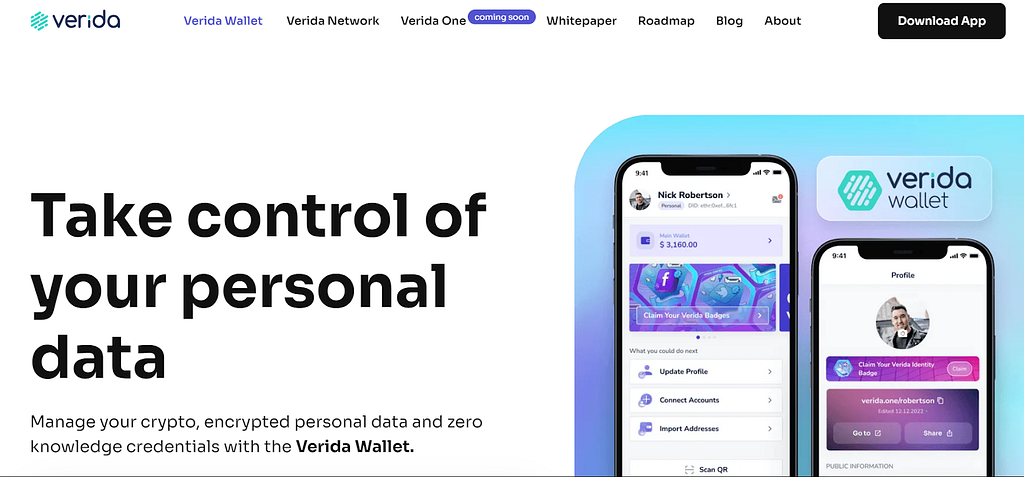 Fig: Verida
Fig: Verida- It primarily deals with managing identity-related data and interactions on the blockchain. While it may interact with transactions, transfers, and blocks on the Ethereum blockchain to facilitate identity-related activities.
- Verida offers tools, libraries, and infrastructure for developers to build decentralized identity solutions and integrate identity management capabilities into their dApps. This includes features such as user authentication, data sharing permissions, identity verification, and secure storage of personal data on the blockchain.
- Users and developers can access such data by querying the Ethereum blockchain directly or using third-party tools and APIs that provide blockchain data analytics and insights. These external sources can offer information about transactions, transfers, block details, token transfers, NFTs, and other relevant data associated with Ethereum-based tokens and transactions.
Flipside Crypto is a data analytics platform that provides insights and analytics for blockchain networks, including Ethereum. The platform aggregates and analyzes on-chain data to offer valuable insights into various aspects of blockchain ecosystems. Here’s an overview of the information conveyed by Flipside Crypto regarding transactions, transfers, trades, blocks, NFTs, and token information:
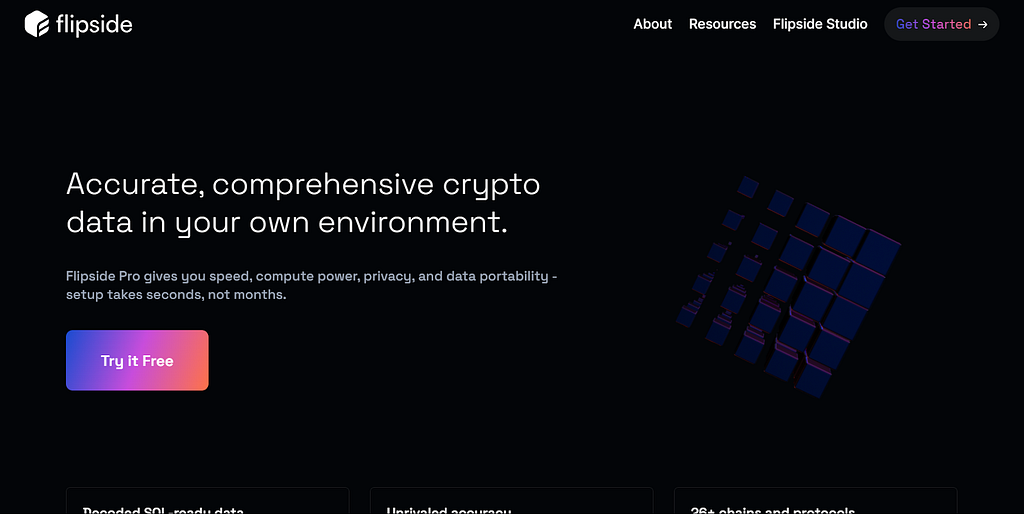 Fig: Flipside
Fig: Flipside- Transactions: Flipside Crypto provides insights into transaction activity on the Ethereum blockchain, including metrics such as transaction volume, transaction counts, and average transaction values. This allows users to analyze transaction trends and patterns over time.
- Transfers: The platform offers information about token transfers on the Ethereum blockchain, including details such as token types, sender and recipient addresses, token amounts transferred, and transaction timestamps. Users can analyze token transfer activity and track token movements across different addresses.
- Trades: Flipside Crypto may provide insights into trading activity on decentralized exchanges (DEXs) and centralized exchanges that are supported by the platform. This includes metrics such as trading volume, liquidity, price movements, and trading pairs. Users can analyze trading activity and monitor market trends for various tokens.
- Blocks: Users can access data and insights about individual blocks on the Ethereum blockchain, including block height, block hashes, timestamps, and the number of transactions included in each block. This allows users to track block production and monitor blockchain activity in real-time.
- NFTs: Flipside Crypto offers information about NFTs on the Ethereum blockchain, including data on NFT token contracts, token metadata, ownership history, transfer transactions, and NFT-related activities. Users can analyze NFT markets, track ownership changes, and monitor trends in the NFT space.
- Token Information: Flipside Crypto provides comprehensive information about Ethereum-based tokens, including token names, symbols, total supplies, market capitalization, trading volume, and historical price data. Users can analyze token metrics, track token performance, and monitor token-related activities in the market.
CryptoQuant is a cryptocurrency data analytics platform that provides insights and data for various aspects of blockchain networks, including Ethereum. Here’s an overview of the information conveyed by CryptoQuant regarding transactions, transfers, trades, blocks, NFTs, and token information:
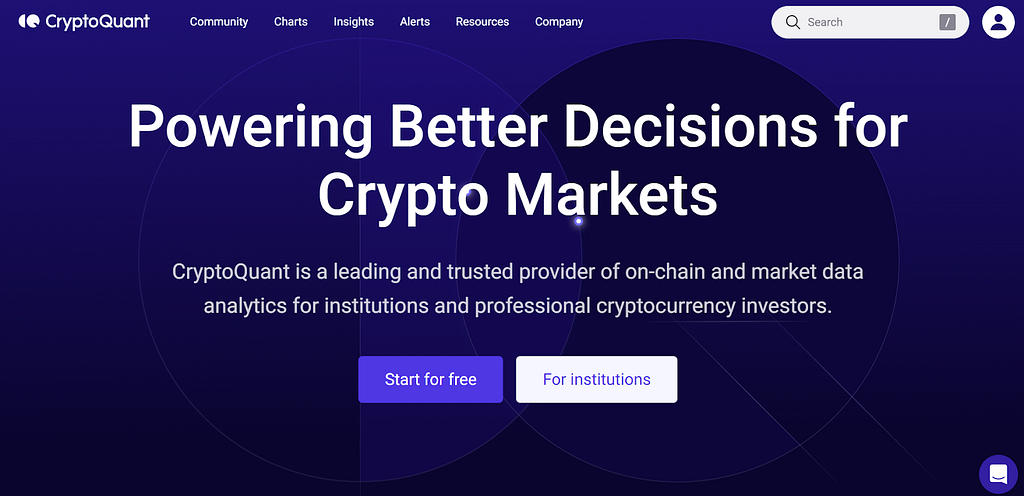 Fig: CryptoQuant
Fig: CryptoQuant- Transactions: CryptoQuant offers insights into transaction activity on the Ethereum blockchain, including metrics such as transaction volume, transaction counts, and average transaction values. Users can analyze transaction trends and patterns over time to gain insights into network activity.
- Transfers: The platform provides data on token transfers on the Ethereum blockchain, including details such as token types, sender and recipient addresses, token amounts transferred, and transaction timestamps. Users can track token movements and analyze transfer activity for different tokens.
- Trades: CryptoQuant may offer insights into trading activity on decentralized exchanges (DEXs) and centralized exchanges that are supported by the platform. This includes metrics such as trading volume, liquidity, price movements, and trading pairs. Users can analyze trading activity and monitor market trends for various tokens.
- Blocks: Users can access data and insights about individual blocks on the Ethereum blockchain, including block height, block hashes, timestamps, and the number of transactions included in each block. This allows users to track block production and monitor blockchain activity in real-time.
- NFTs: CryptoQuant may provide data on NFTs on the Ethereum blockchain, including information about NFT token contracts, token metadata, ownership history, transfer transactions, and NFT-related activities. Users can analyze NFT markets, track ownership changes, and monitor trends in the NFT space if such data is available on the platform.
- Token Information: CryptoQuant offers information about Ethereum-based tokens, including token names, symbols, total supplies, market capitalization, trading volume, and historical price data. Users can analyze token metrics, track token performance, and monitor token-related activities in the market.
Transpose is a data infrastructure platform designed to facilitate the integration, transformation, and analysis of blockchain data. Here’s how Transpose can be utilized to convey information about transactions, transfers, trades, blocks, NFTs, and token information:
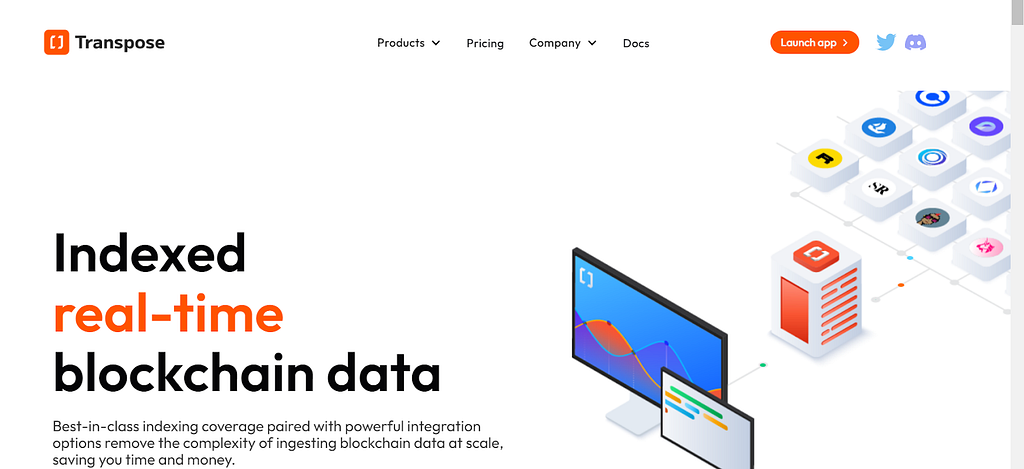 Fig: Transpose
Fig: Transpose- Data Integration: Transpose allows developers to integrate data from various blockchain sources, including Ethereum, into their applications and systems. This includes importing data about transactions, transfers, trades, blocks, NFTs, and token information from blockchain networks.
- Data Transformation: With Transpose, developers can transform raw blockchain data into a format that is suitable for analysis and visualization. This may involve cleaning and structuring data, performing calculations or aggregations, and standardizing data schemas.
- Data Analysis: Transpose provides tools and capabilities for analyzing blockchain data once it has been integrated and transformed. This includes querying data to extract insights, visualizing data through charts and graphs, and performing advanced analytics to identify patterns and trends.
- Data Access Control: Transpose offers features for managing access to blockchain data, ensuring that sensitive information is protected and only accessible to authorized users or applications. This includes role-based access control, encryption, and data masking capabilities.
- Data Governance: Transpose enables organizations to establish governance policies and procedures for managing blockchain data effectively. This includes defining data retention policies, establishing data quality standards, and implementing audit trails for tracking data access and usage.
Whalemap is a cryptocurrency data analytics platform that focuses on providing insights into whale activity in the cryptocurrency markets. Specifically, Whalemap analyzes large transactions, movements of funds by significant holders (referred to as “whales”), and other on-chain metrics to identify trends and patterns in market behavior. Here’s an overview of the information conveyed by Whalemap:
 Fig: Whalemap
Fig: Whalemap- Transaction Analysis: Whalemap provides insights into large transactions occurring on the blockchain, allowing users to track significant movements of funds by large holders or “whales.” This analysis can help traders and investors gauge market sentiment and identify potential areas of support or resistance.
- Whale Activity: The platform tracks the activity of large holders (whales) and provides insights into their accumulation, distribution, or liquidation of assets. By monitoring whale activity, users can gain insights into market trends and potential price movements.
- On-chain Metrics: Whalemap offers various on-chain metrics, such as wallet balances, transaction volumes, and historical data on whale activity. These metrics can be used to analyze market trends, identify accumulation or distribution patterns, and assess the overall health of the market.
Lava Network is a decentralized financial platform built on the Ethereum blockchain that primarily focuses on providing liquidity provision and yield farming opportunities. While Lava Network facilitates transactions, transfers, and trades of Ethereum-based tokens
- Users interact with Lava Network through their Ethereum wallets or compatible decentralized applications (dApps), where they can participate in liquidity pools, swap tokens, and engage in yield farming strategies.
- Instead, users and developers can access such data by querying the Ethereum blockchain directly or using third-party tools and APIs that provide blockchain data analytics and insights.
- These external sources can offer information about transactions, transfers, block details, token transfers, NFTs, and other relevant data associated with Ethereum-based tokens and transactions.
Ceramic operates as a decentralized network and protocol, emphasizing the establishment of a secure and interoperable infrastructure tailored for data exchange and identity management. Positioned as a fundamental layer, Ceramic facilitates the construction of decentralized applications (dApps) and systems designed to manage such data effectively. Here’s how Ceramic can be harnessed to transmit information concerning transactions, transfers, trades, blocks, NFTs, and token information:
 Fig: Ceramic
Fig: Ceramic- Decentralized Identity: Ceramic facilitates the establishment and administration of decentralized identities (DIDs) on the blockchain. This empowers users to create unique identities that are self-sovereign and cryptographically secure, enabling them to engage with decentralized applications (dApps) and services while retaining control over their personal data and identity.
- Data Streams: With Ceramic, developers have the capability to generate and oversee data streams that are immutable, verifiable, and interoperable across diverse platforms and applications. These data streams serve as channels for conveying information pertaining to various on-chain activities, including transactions, transfers, and token trades.
- Immutable Records: Leveraging the blockchain’s immutable properties, Ceramic creates unalterable records of data and transactions. This guarantees that once information is logged on the blockchain through Ceramic, it remains intact and cannot be modified or erased, fostering transparency and reliability.
- Decentralized Applications: Utilizing Ceramic’s infrastructure, developers can construct decentralized applications (dApps) that harness its capabilities for managing transactions, transfers, token trades, and other on-chain activities. These dApps may incorporate functionalities such as NFT creation, token transfers, and interactions with smart contracts.
- Interoperability: Ceramic facilitates seamless interoperability between disparate blockchain networks and protocols, facilitating the smooth flow of data across them. This ensures that details regarding transactions, transfers, token trades, NFTs, and token information are readily accessible and exchangeable among various decentralized applications and systems.
Spring is a decentralized finance (DeFi) platform built on the Ethereum blockchain that primarily focuses on providing liquidity provision and yield farming opportunities. While Spring facilitates transactions, transfers, and trades of Ethereum-based tokens through its protocol or platform.
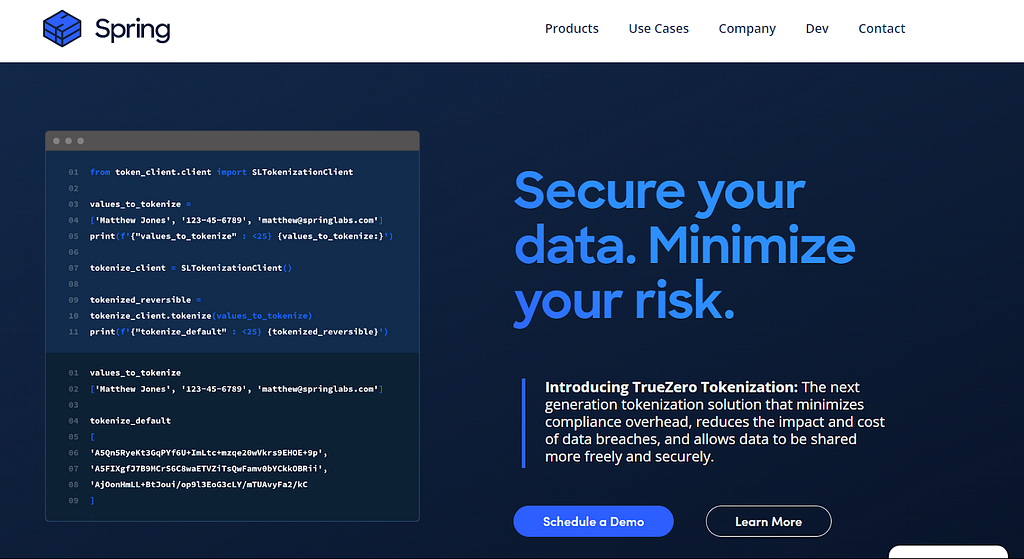 Fig: Spring
Fig: Spring- Users interact with Spring through their Ethereum wallets or compatible decentralized applications (dApps), where they can participate in liquidity pools, swap tokens, and engage in yield farming strategies.
- Instead, users and developers can access such data by querying the Ethereum blockchain directly or using third-party tools and APIs that provide blockchain data analytics and insights.
- These external sources can offer information about transactions, transfers, block details, token transfers, NFTs, and other relevant data associated with Ethereum-based tokens and transactions.
Bundlr is a decentralized finance (DeFi) protocol built on the Ethereum blockchain that focuses on providing liquidity aggregation and yield optimization for users participating in decentralized exchanges (DEXs). While Bundlr facilitates transactions, transfers, and trades of Ethereum-based tokens through its protocol or platform.
- Users interact with Bundlr through their Ethereum wallets or compatible decentralized applications (dApps), where they can aggregate liquidity from multiple DEXs, optimize trading routes, and access liquidity pools with minimized slippage.
- Instead, users and developers can access such data by querying the Ethereum blockchain directly or using third-party tools and APIs that provide blockchain data analytics and insights.
- These external sources can offer information about transactions, transfers, block details, token transfers, NFTs, and other relevant data associated with Ethereum-based tokens and transactions.
Airstack is a platform for decentralized applications (dApps) that provides a framework and tools for developers to build, deploy, and manage their applications on blockchain networks, including Ethereum.
- Instead, Airstack serves as a development environment and infrastructure for building decentralized applications that may interact with blockchain networks. Developers can utilize Airstack to create dApps that handle transactions, transfers, trades, and other on-chain activities.
- Users and developers building dApps on Airstack may integrate with external APIs, blockchain explorers, or data analytics platforms to access information about transactions, transfers, blocks, NFTs, and token information.
- These external sources can provide data analytics and insights related to Ethereum-based tokens and transactions, allowing developers to build applications that utilize such information effectively.
PARSIQ is a platform specializing in blockchain monitoring and intelligence, furnishing users with real-time data and notifications concerning blockchain transactions and events. It equips users with tools and services essential for monitoring and dissecting blockchain activity. Here’s a glimpse of how PARSIQ can be leveraged to communicate information regarding transactions, transfers, trades, blocks, NFTs, and token details:
 Fig: PARSIQ
Fig: PARSIQ- Transaction Monitoring: PARSIQ empowers users to observe blockchain transactions in real-time, encompassing particulars like transaction hashes, sender and recipient addresses, transaction sums, gas fees, and timestamps. Users can configure alerts for specific transaction types or addresses to receive notifications upon meeting predefined criteria.
- Transfer Tracking: The platform facilitates the tracking of token transfers on the blockchain, furnishing details about token categories, sender and recipient addresses, transfer amounts, and transaction timestamps. Users can monitor token movements and scrutinize transfer activities across diverse addresses.
- Trade Analysis: PARSIQ may furnish tools for scrutinizing trading activities on both decentralized exchanges (DEXs) and centralized exchanges. This includes assessing metrics such as trading volume, liquidity, price fluctuations, and trading pairs. Users can monitor trade activity and discern market trends for various tokens.
- Block Insights: PARSIQ offers insights into individual blocks on the blockchain, including attributes like block height, block hashes, timestamps, and the number of transactions encapsulated in each block. Users can track block production and observe blockchain activity in real-time.
- NFT Monitoring: Although PARSIQ may not directly facilitate NFT monitoring, users can utilize its capabilities to monitor specific smart contracts or addresses linked to NFT transactions. This enables users to track NFT-related occurrences such as token creation, transfers, and sales.
- Token Analytics: PARSIQ provides tools for scrutinizing Ethereum-based tokens, presenting information regarding token names, symbols, total supplies, market capitalization, trading volume, and historical price data. Users can analyze token metrics and monitor token-related activities within the market.
Token Flow is a blockchain analytics platform that specializes in providing insights into token transfers and on-chain transactions. Here’s an overview of the information conveyed by Token Flow regarding transactions, transfers, trades, blocks, NFTs, and token information:
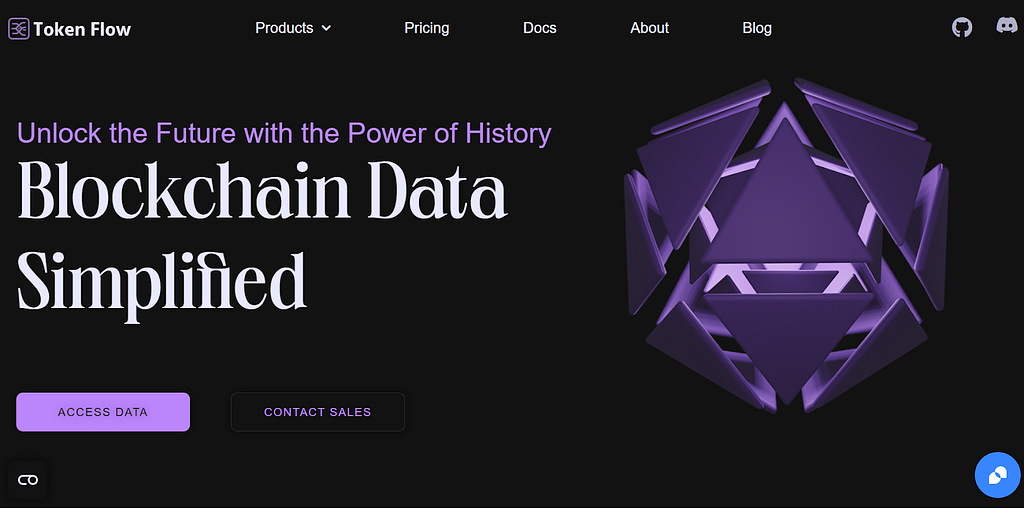 Fig: Token Flow
Fig: Token Flow- Token Transfers: Token Flow provides detailed information about token transfers on the blockchain, including data such as token types, sender and recipient addresses, transfer amounts, transaction timestamps, and transaction hashes. Users can analyze token transfer activity and track the movement of tokens across different addresses.
- Transaction Analysis: The platform offers insights into blockchain transactions, including metrics such as transaction volume, transaction counts, and average transaction values. Users can analyze transaction trends and patterns over time to gain insights into network activity.
- Trade Monitoring: Token Flow may provide tools for monitoring trading activity on decentralized exchanges (DEXs) and centralized exchanges. This includes metrics such as trading volume, liquidity, price movements, and trading pairs. Users can monitor trading activity and identify market trends for various tokens.
- Block Details: Users can access data and insights about individual blocks on the blockchain through Token Flow, including block height, block hashes, timestamps, and the number of transactions included in each block. This allows users to track block production and monitor blockchain activity in real-time.
- NFT Tracking: While Token Flow may not directly support NFT tracking, users can potentially leverage its capabilities to monitor specific smart contracts or addresses associated with NFT transactions. This enables users to track NFT-related events such as token minting, transfers, and sales.
- Token Analytics: Token Flow provides comprehensive information about Ethereum-based tokens, including token names, symbols, total supplies, market capitalization, trading volume, and historical price data. Users can analyze token metrics and monitor token-related activities in the market.
In conclusion, Ethereum API serves as a crucial gateway for developers to interact with the Ethereum blockchain programmatically, enabling the creation of decentralized applications (dApps) and smart contracts. With Ethereum’s introduction of smart contracts, the landscape of blockchain technology has been transformed, ushering in an era where agreements can be automatically executed without the need for intermediaries.
This innovation has led to the development of trustless and transparent systems across various sectors, including finance, NFTs, decentralized identity, supply chain management, and governance.
The use of Ethereum on-chain data further enhances the potential of the Ethereum ecosystem, offering valuable insights and analysis for various purposes. From transaction analysis to smart contract monitoring, token analytics, DeFi analysis, market intelligence, NFT analysis, blockchain forensics, compliance, and research and development, Ethereum on-chain data provides a wealth of information that can be leveraged to drive innovation and advance the adoption of blockchain technology.
As the Ethereum ecosystem continues to evolve and expand, the utilization of Ethereum API and on-chain data will play an increasingly significant role in shaping the future of decentralized applications and blockchain technology.
Also Read
- Top 7 Moralis Alternatives
- Moralis vs Alchemy vs Bitquery
- Quicknode vs Bitquery vs Moralis
- Top 6 Etherscan API Alternatives
- Filecoin data API
- 14 Best Crypto API & Blockchain APIs for Developers
- Top 10 Blockchain data APIs (Indexed Data Provider)
- Top 10 blockchain cloud data providers
- Top Token Holders API
- Best Algorand API Providers

Best Ethereum API was originally published in Coinmonks on Medium, where people are continuing the conversation by highlighting and responding to this story.
